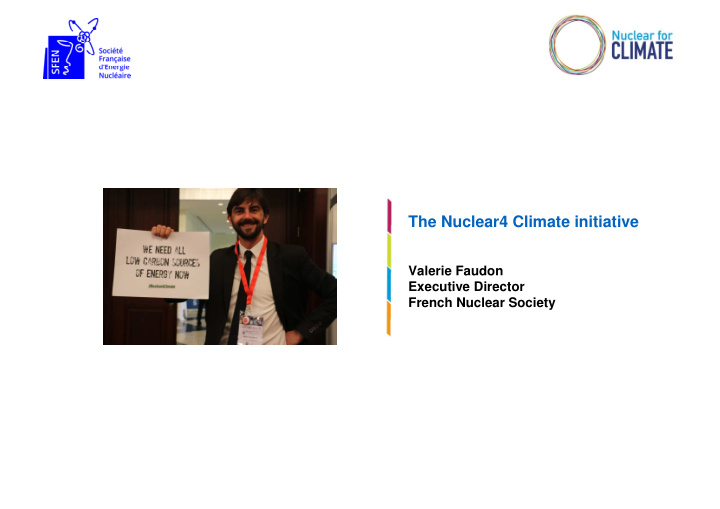



The Nuclear4 Climate initiative Valerie Faudon Executive Director French Nuclear Society
To limit the temperature increase below 2°C in 2050.. Today, it is about 30% 2013 world electricity generation by source Oil Gas 5% ..at least 80% of 22% the world’s Nuclear 11% electricity must be Other low-carbon by 32% Hydro 16% 2050. Other renewables 5% Coal 41% Source: IPCC WG1 2014 Source: AIE-WEO 2014 This is a massive global challenge that requires the use of all available low-carbon energy technologies.
Major progress in energy efficiency will not be sufficient: the electricity demand is expected to double by 2050 Electricity demand and share of electricity (IEA) By 2050: the world’s population will be around 9.6 billion Today: � 1.2 billion people do not have access to electricity � 2.8 billion use wood or other biomass products for cooking and � heating Strong demand from non-OECD countries � Increased share of electricity in the overall energy mix Source: UN, World Bank Source: AIE-AEN Technology roadmap 2015 The fight against climate change should not jeopardize development
The IPCC identifies three types of carbon-free electricity: renewables, nuclear and CCS (Carbon Capture & Storage) . The amount of CO2 emitted by nuclear energy is comparable to that of renewables
It is urgent to use now all available low-carbon energy sources 70% of the carbon budget has been consumed Once released, CO2 remains in the atmosphere for a long time. Carbon budget: cumulative CO2 emissions that must not be exceeded if we are to contain average global warming to 2°C. Gt CO2 3500 3000 We cannot wait for future technologies 2500 : 2000 Remaining they will contribute in proportion to 1500 Since pre- their availability . industrial era 1000 500 0 Carbon budget Source: IPCC
Nuclear energy is an available, low-carbon and efficient industrial solution, that has been proven efficient 438 nuclear reactors in operation, nuclear energy is available in 30 countries. Today, only 6 countries above 80% goal of low- carbon electricity, 4 of them have nuclear . Sweden 40% nuclear Switzerland 40% nuclear France 75% nuclear Brazil 2 nuclear reactors Source: IAEA, IEA Since 1971 nuclear power has avoided the release of the equivalent of 2 years of CO 2 emissions. By 2040, nuclear power should save the equivalent of 4 years of CO 2 emissions. Source: WEO 2014
Very few scenarios enable to limit global warming below 2° without nuclear " There is no credible way to climate stabilization that does not include an important role for nuclear energy …. we cannot afford to turn our back on any technology". Open letter from environmentalists, Washington Post, Oct 2013 IPCC WG3: only 8 scenarios out of 1 200 show limitation below 2° and nuclear phase-out. Every country must have access to the largest portfolio of low-carbon technologies, including nuclear
Most scenarios limiting the temperature increase to 2°C show a very significant contribution of nuclear energy IEA Scenario 2DS: Installed capacity by country Source: IEA technology roadmap, Jan 2015 � Gross nuclear capacity should double by 2050, from 400 GWe to 930 GWe. � Share of nuclear power in the global energy mix to increase from 11% to 17%. � Stability in OECD (long time operations), and strong growth in BRICs & Middle East: 70+ reactors being constructed WW
Access to climate funding mechanisms UNFCC Kyoto Protocol Nuclear energy discriminated against within the Marrakesh Accords (2002) An estimated investment in nuclear of « Parties.. should refrain from using credits (from USD 4.4 trillion needed WW by 2050*, CDM 1 or JI 2 projects) generated from nuclear facilities to meet their commitments 3 » - Incl. USD 700 Bn in the EU Source: OECD-AEN, 2DS 1 Clean Development Mechanisms 2 Joint Implementation projects 3 emission targets agreed under the Kyoto protocols 3 UNFCCC Protocols must allow countries who wish to use nuclear energy to have access to climate change financing, as is the case for all other low-carbon energy sources.
A joint statement in ICAPP, Nice, May 4, 2015 “WE PROUDLY BELIEVE THAT NUCLEAR ENERGY IS A KEY PART OF THE SOLUTION IN THE FIGHT AGAINST CLIMATE CHANGE” 39 nuclear societies 50,000 scientists 36 countries
MERCI ! @Nuclear4Climate www.sfen.org
Recommend
More recommend